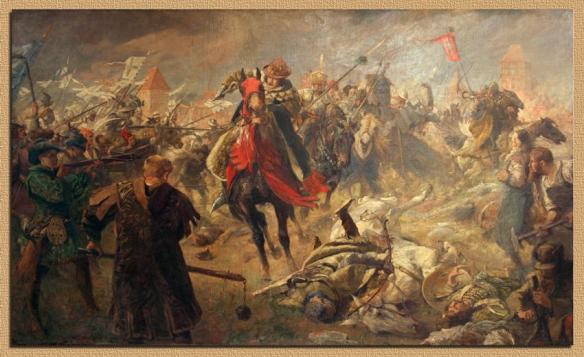Conitz or Konitz. The first major battle of the “War of the Cities” (1454-1466), fought between Poland- Lithuania and the Teutonic Knights. The Poles, led personally by Casimir IV, anticipated support from Prussian peasants then in rebellion against the warrior monks, their hard overlords. The Polish army of 16,000 men was itself mostly drawn from feudal peasant levies, badly officered by quarrelsome nobles. Chojnice was a critical entrepôt and a main base of the remaining economic power of the Teutonic Knights, which a small force of Saxons occupied in their behalf. The city had been under ineffective siege by a Prussian peasant army, and some mercenaries, since April. But a combination of inept Polish officering and a shortfall of Prussian monies to pay the mercenaries left the city in Teuton-Saxon hands. Casimir now ordered his main army to Chojnice. Since the great strength of the Poles was noble cavalry, and since fortified towns rarely if ever succumbed to horse soldiers who disdained sapping or trench work, the city stood firm. In early September a large band of German mercenaries (9,000 horse and 6,000 foot) arrived in answer to a summons from the Teutonic Knights. These professionals gave the advantage to the Knights who, along with levies of peasant conscripts, smashed the Polish army and nearly captured Casimir.
The battle
At the beginning everything went as expected, following the pattern of many other battles between the Poles and Teutonic Knights. The Polish cavalry charged, breaking the Teutonic lines, killing Prince Rudolf of Żagań and even capturing Bernard von Zinnenberg. The Teutonic cavalry tried to break through the Polish lines and escape to Chojnice; however, infantry grouped at the Teutonic Wagenburg broke with tradition and offered a very good defense against the mounted troops.
Then a sudden sally from Chojnice at the back of the Polish army caused panic. Bernard von Zinnenberg managed to release himself and organised the pursuit; hundreds of Poles, including Piotr from Szczekociny, were killed during the rout or drowned in nearby marshland. The Polish King fought on with great personal courage and his knights had to force him to leave the battlefield.
Aftermath
The Polish defeat was complete. 3,000 bodies were left on the battlefield, 300 knights were captured by the Teutonic Knights, including three main commanders: Mikolaj Szarlejski, Łukasz Górka, and Wojciech Kostka from Postupice. The Teutonic Knights lost only around 100 men. Bernard von Zinnenberg, was however, formally a Polish prisoner, since he gave a knight’s word.
The battle proved that discipline and improved tactics, combined with a talented commander could win against a larger, but more traditional army. The Poles paid the price for ignoring terrain, infantry and artillery.
The Teutons went on to recapture numerous Prussian towns. Unfortunately for the Knights, however, they did not have the money to pay such a large mercenary force. The Grand Master of the Order was therefore forced to promise Prussian cities as collateral to the Germans in the event he could not meet the payroll due in February 1455. This deal cost the Teutonic Knights the war in the end as they lost mercenary support and the greater strength and manpower of Poland told against them. But for awhile longer the victory at Chojnice and the infusion of German mercenaries meant the war continued.
